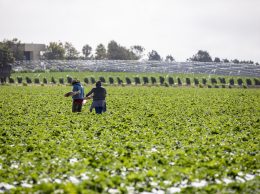State of Santa Barbara County: waiting for vaccines, making do in the meantime
IN THIS ARTICLE
- Central Coast Topic
- pacbiztimes Author
By pacbiztimes Friday, December 11th, 2020
The pandemic has hit Santa Barbara County in a myriad of ways, making life harder for everyone, but the county is still trying to wring a few good measures out of hard situations.
At the annual State of the County address on Dec. 11, put on by a coalition of the county’s chambers of commerce, several county and regional leaders spoke about the impact COVID-19 is having and how the area is working to help fix it.
Gregg Hart, the chair of the Santa Barbara County Board of Supervisors, was the first public official to take the podium. He thanked the county’s Public Health Department, as well as the rest of the county’s workers, for their diligence during the pandemic, and said that if the current thinking holds, the area should start seeing vaccines for healthcare workers shortly, and for the rest of the area within a few months.
“We should be seeing wider availability for vaccines for the general public in the spring and summer,” Hart said.
The vaccines will clear the way for life to start returning to normal, but Hart stressed the importance of making sure everyone has access to both the vaccine and to vital healthcare information to help keep themselves safe until the vaccine is released. In order to reach as many people as possible the county has invested in more immediate Spanish-language interpretation services, he said.
The county is also working to protect resident who are especially vulnerable to COVID-19. More than 40 homeless people have been transitioned into permanent housing, and Hart said the county has undertaken special projects to reduce youth and veteran homelessness.
Those projects and services need funding, though, and County Executive Officer Mona Miyasato addressed the pandemic’s impacts on the county budget. The pandemic has impacted government funding and spending on all levels, but Santa Barbara County has been lucky, Miyasato said. Cannabis taxes have been critical in filling the gaps left by declines in sales and hotel taxes, and unlike the previous recession, property taxes seem like they’ll be staying at similar levels, which will also help.
Even with those taxes, Peter Rupert, a professor of economics at UC Santa Barbara and the director of the UCSB Economic Forecast Project, said the area can expect to see some government programs end and a structural deficit over the next several years because of the pandemic.
“We’re in a war (against this virus), and that’s something I think we need to take a little more seriously,” Rupert said.
To that end, while Santa Barbara has not been seeing the surge in cases of larger areas like Los Angeles or even Ventura County, Rupert warned it wouldn’t take much for Santa Barbara to see high case numbers impacting the region.
And among the people who are hit hardest by COVID-19 surges are retail, restaurant and hospitality workers, who are the least likely to have savings and access to financial resources to help them weather the storm.
“If we’re not going to see widespread (vaccine) distribution until summer, we have a lot to do until then,” Rupert said.
Nancy Anderson, the assistant county executive officer, spoke about some of what the county has done during this time to make it easier for businesses to operate. Until outdoor dining was recently prohibited by the state, the county struck down regulations and made it easier for restaurants to serve more people outside.
Additionally, when the state required wineries and breweries to only serve alcoholic beverages if there was a meal attached, the county issued permits to allow those businesses to offer food and team up with catering services.
“We want to thank our business community for the effort they are putting in to protect their employees and the community,” Anderson said.











